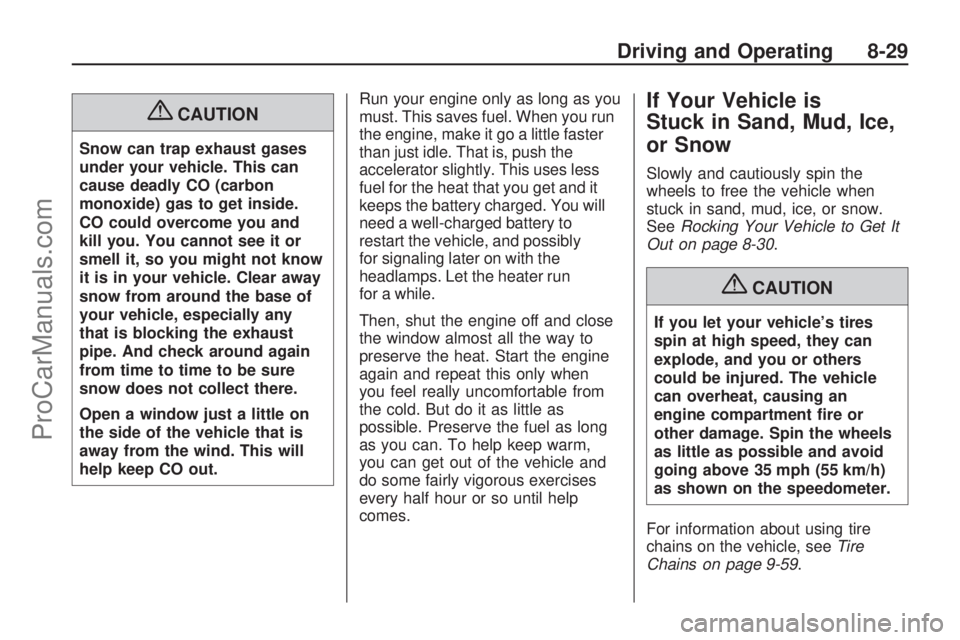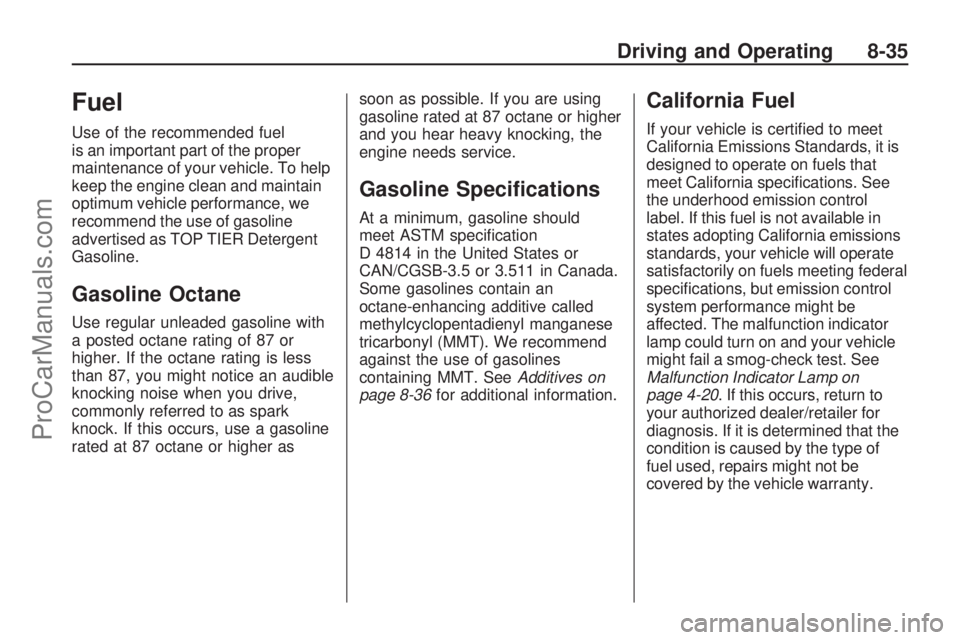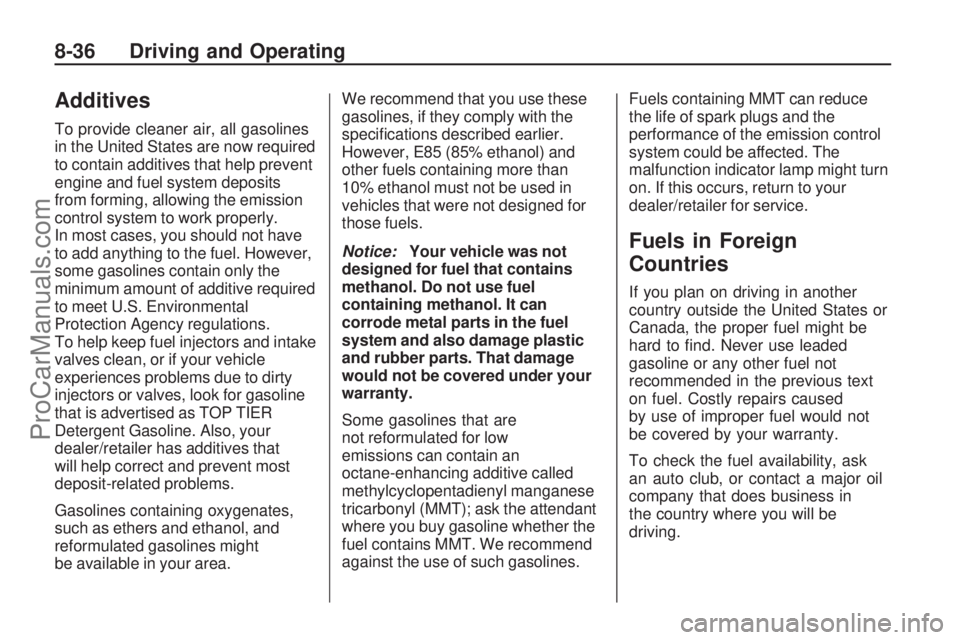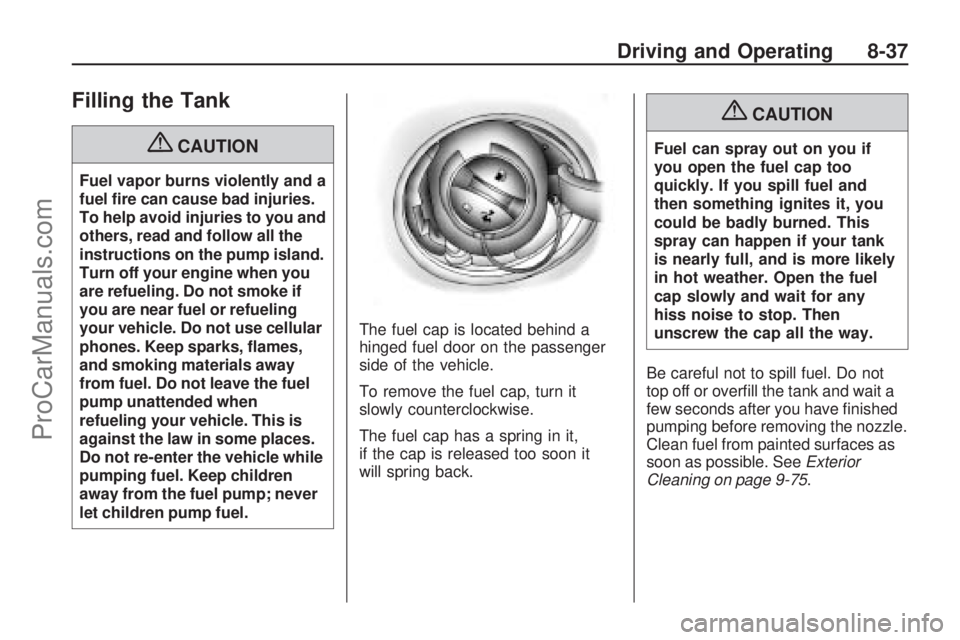SATURN ASTRA 2008 Owners Manual
Manufacturer: SATURN, Model Year: 2008, Model line: ASTRA, Model: SATURN ASTRA 2008Pages: 304, PDF Size: 1.92 MB
Page 181 of 304

{CAUTION
Snow can trap exhaust gases
under your vehicle. This can
cause deadly CO (carbon
monoxide) gas to get inside.
CO could overcome you and
kill you. You cannot see it or
smell it, so you might not know
it is in your vehicle. Clear away
snow from around the base of
your vehicle, especially any
that is blocking the exhaust
pipe. And check around again
from time to time to be sure
snow does not collect there.
Open a window just a little on
the side of the vehicle that is
away from the wind. This will
help keep CO out.Run your engine only as long as you
must. This saves fuel. When you run
the engine, make it go a little faster
than just idle. That is, push the
accelerator slightly. This uses less
fuel for the heat that you get and it
keeps the battery charged. You will
need a well-charged battery to
restart the vehicle, and possibly
for signaling later on with the
headlamps. Let the heater run
for a while.
Then, shut the engine off and close
the window almost all the way to
preserve the heat. Start the engine
again and repeat this only when
you feel really uncomfortable from
the cold. But do it as little as
possible. Preserve the fuel as long
as you can. To help keep warm,
you can get out of the vehicle and
do some fairly vigorous exercises
every half hour or so until help
comes.
If Your Vehicle is
Stuck in Sand, Mud, Ice,
or Snow
Slowly and cautiously spin the
wheels to free the vehicle when
stuck in sand, mud, ice, or snow.
SeeRocking Your Vehicle to Get It
Out on page 8-30.
{CAUTION
If you let your vehicle’s tires
spin at high speed, they can
explode, and you or others
could be injured. The vehicle
can overheat, causing an
engine compartment �re or
other damage. Spin the wheels
as little as possible and avoid
going above 35 mph (55 km/h)
as shown on the speedometer.
For information about using tire
chains on the vehicle, seeTire
Chains on page 9-59.
Driving and Operating 8-29
ProCarManuals.com
Page 182 of 304

Rocking Your Vehicle to
Get It Out
First, turn the steering wheel left and
right to clear the area around the
front wheels. Turn off any stability
system. SeeStabiliTrak
®System on
page 8-19. Then shift back and forth
between REVERSE (R) and a
forward gear, or with a manual
transmission, between FIRST (1) or
SECOND (2) and REVERSE (R),
spinning the wheels as little as
possible. To prevent transmission
wear, wait until the wheels stop
spinning before shifting gears.Release the accelerator pedal
while you shift, and press lightly
on the accelerator pedal when
the transmission is in gear. By slowly
spinning the wheels in the forward
and reverse directions, you will
cause a rocking motion that could
free your vehicle. If that does not get
your vehicle out after a few tries, it
might need to be towed out. If your
vehicle does need to be towed out,
seeTowing Your Vehicle on
page 9-72.
Loading the Vehicle
It is very important to know how
much weight your vehicle can
carry. This weight is called the
vehicle capacity weight and
includes the weight of all
occupants, cargo and all
nonfactory-installed options.
Two labels on your vehicle
show how much weight it may
properly carry, the Tire and
Loading Information label and
the Certi�cation label.
8-30 Driving and Operating
ProCarManuals.com
Page 183 of 304

{CAUTION
Do not load the vehicle any
heavier than the Gross
Vehicle Weight Rating
(GVWR), or either the
maximum front or rear
Gross Axle Weight Rating
(GAWR). If you do, parts on
the vehicle can break, and it
can change the way your
vehicle handles. These
could cause you to lose
control and crash. Also,
overloading can shorten
the life of the vehicle.Tire and Loading Information
Label
A vehicle speci�c Tire and
Loading Information label
is attached to the vehicle’s
center pillar (B-pillar). With the
driver’s door open, you will
�nd the label attached below
the door lock post. The Tireand Loading Information label
shows the number of occupant
seating positions (A), and
the maximum vehicle capacity
weight (B) in kilograms and
pounds.
The Tire and Loading
Information label also shows the
tire size of the original equipment
tires (C) and the recommended
cold tire in�ation pressures (D).
For more information on tires and
in�ation seeTires on page 9-38
andInflation - Tire Pressure on
page 9-46.
There is also important loading
information on the Certi�cation
label. It tells you the Gross
Vehicle Weight Rating (GVWR)
and the Gross Axle Weight
Rating (GAWR) for the front and
rear axle; see “Certi�cation
Label” later in this section.
Label Example
Driving and Operating 8-31
ProCarManuals.com
Page 184 of 304

Steps for Determining Correct
Load Limit
1.Locate the statement “The
combined weight of occupants
and cargo should never
exceed XXX kg or XXX lbs”
on your vehicle placard.
2.Determine the combined
weight of the driver and
passengers that will be riding
in your vehicle.
3.Subtract the combined weight
of the driver and passengers
from XXX kg or XXX lbs.
4.The resulting �gure equals the
available amount of cargo and
luggage load capacity. For
example, if the “XXX” amount
equals 1400 lbs and there will
be �ve 150 lb passengers in
your vehicle, the amount of
available cargo and luggage
load capacity is 650 lbs
(1400−750 (5 x 150) =
650 lbs).
5.Determine the combined
weight of luggage and
cargo being loaded on the
vehicle. That weight may not
safely exceed the available
cargo and luggage load
capacity calculated in Step 4.
6.If your vehicle will be towing
a trailer, the load from your
trailer will be transferred
to your vehicle. Consult this
manual to determine how
this reduces the available
cargo and luggage load
capacity of your vehicle.
The vehicle is neither designed
nor intended to tow a trailer.
A.Vehicle Capacity Weight for
Example 1=1,000 lbs
(453 kg).
B.Subtract Occupant Weight
150 lbs (68 kg)×2=300 lbs
(136 kg).
C.Available Occupant and
Cargo Weight=700 lbs
(317 kg).
Example 1
8-32 Driving and Operating
ProCarManuals.com
Page 185 of 304

A.Vehicle Capacity Weight for
Example 2=1,000 lbs
(453 kg).
B.Subtract Occupant Weight
150 lbs (68 kg)×5=750 lbs
(340 kg).
C.Available Cargo
Weight=250 lbs (113 kg).
A.Vehicle Capacity Weight for
Example 3=1,000 lbs
(453 kg).
B.Subtract Occupant
Weight 200 lbs
(91 kg)×5=1,000 lbs
(453 kg).
C.Available Cargo
Weight=0 lbs (0 kg).
Refer to the vehicle’s Tire and
Loading Information label for
speci�c information about thevehicle’s capacity weight and
seating positions. The combined
weight of the driver, passengers,
and cargo should never exceed
the vehicle’s capacity weight.
Certi�cation Label
A vehicle speci�c Certi�cation
label, found on the rear edge
of the driver’s door, tells you
the gross weight capacity of
the vehicle, called the Gross
Vehicle Weight Rating (GVWR).
Example 2Example 3
Label Example
Driving and Operating 8-33
ProCarManuals.com
Page 186 of 304

The GVWR includes the weight
of the vehicle, all occupants,
fuel, and cargo. Never exceed
the GVWR for your vehicle,
or the Gross Axle Weight Rating
(GAWR) for either the front or
rear axle.
And, if you do have a heavy
load, you should spread it out.
See “Steps for Determining
Correct Load Limit” earlier in
this section.
{CAUTION
Do not load the vehicle any
heavier than the Gross
Vehicle Weight Rating
(GVWR), or either the
maximum front or rear Gross
Axle Weight Rating (GAWR).
(Continued)
CAUTION (Continued)
If you do, parts on the
vehicle can break, and it can
change the way your vehicle
handles. These could cause
you to lose control and
crash. Also, overloading
can shorten the life of the
vehicle.
If you put things inside your
vehicle — like suitcases,
tools, packages, or anything
else — they will go as fast as
the vehicle goes. If you have
to stop or turn quickly, or if
there is a crash, they will
keep going.{CAUTION
Things you put inside the
vehicle can strike and injure
people in a sudden stop or
turn, or in a crash.
Put things in the trunk of
your vehicle. In a trunk,
put them as far forward as
you can. Try to spread the
weight evenly.
Never stack heavier
things, like suitcases,
inside the vehicle so that
some of them are above
the tops of the seats.
Do not leave an
unsecured child restraint
in the vehicle.
When you carry
something inside the
vehicle, secure it
whenever you can.
Do not leave a seat folded
down unless you need to.
8-34 Driving and Operating
ProCarManuals.com
Page 187 of 304

Fuel
Use of the recommended fuel
is an important part of the proper
maintenance of your vehicle. To help
keep the engine clean and maintain
optimum vehicle performance, we
recommend the use of gasoline
advertised as TOP TIER Detergent
Gasoline.
Gasoline Octane
Use regular unleaded gasoline with
a posted octane rating of 87 or
higher. If the octane rating is less
than 87, you might notice an audible
knocking noise when you drive,
commonly referred to as spark
knock. If this occurs, use a gasoline
rated at 87 octane or higher assoon as possible. If you are using
gasoline rated at 87 octane or higher
and you hear heavy knocking, the
engine needs service.
Gasoline Speci�cations
At a minimum, gasoline should
meet ASTM speci�cation
D 4814 in the United States or
CAN/CGSB-3.5 or 3.511 in Canada.
Some gasolines contain an
octane-enhancing additive called
methylcyclopentadienyl manganese
tricarbonyl (MMT). We recommend
against the use of gasolines
containing MMT. SeeAdditives on
page 8-36for additional information.
California Fuel
If your vehicle is certi�ed to meet
California Emissions Standards, it is
designed to operate on fuels that
meet California speci�cations. See
the underhood emission control
label. If this fuel is not available in
states adopting California emissions
standards, your vehicle will operate
satisfactorily on fuels meeting federal
speci�cations, but emission control
system performance might be
affected. The malfunction indicator
lamp could turn on and your vehicle
might fail a smog-check test. See
Malfunction Indicator Lamp on
page 4-20. If this occurs, return to
your authorized dealer/retailer for
diagnosis. If it is determined that the
condition is caused by the type of
fuel used, repairs might not be
covered by the vehicle warranty.
Driving and Operating 8-35
ProCarManuals.com
Page 188 of 304

Additives
To provide cleaner air, all gasolines
in the United States are now required
to contain additives that help prevent
engine and fuel system deposits
from forming, allowing the emission
control system to work properly.
In most cases, you should not have
to add anything to the fuel. However,
some gasolines contain only the
minimum amount of additive required
to meet U.S. Environmental
Protection Agency regulations.
To help keep fuel injectors and intake
valves clean, or if your vehicle
experiences problems due to dirty
injectors or valves, look for gasoline
that is advertised as TOP TIER
Detergent Gasoline. Also, your
dealer/retailer has additives that
will help correct and prevent most
deposit-related problems.
Gasolines containing oxygenates,
such as ethers and ethanol, and
reformulated gasolines might
be available in your area.We recommend that you use these
gasolines, if they comply with the
speci�cations described earlier.
However, E85 (85% ethanol) and
other fuels containing more than
10% ethanol must not be used in
vehicles that were not designed for
those fuels.
Notice:Your vehicle was not
designed for fuel that contains
methanol. Do not use fuel
containing methanol. It can
corrode metal parts in the fuel
system and also damage plastic
and rubber parts. That damage
would not be covered under your
warranty.
Some gasolines that are
not reformulated for low
emissions can contain an
octane-enhancing additive called
methylcyclopentadienyl manganese
tricarbonyl (MMT); ask the attendant
where you buy gasoline whether the
fuel contains MMT. We recommend
against the use of such gasolines.Fuels containing MMT can reduce
the life of spark plugs and the
performance of the emission control
system could be affected. The
malfunction indicator lamp might turn
on. If this occurs, return to your
dealer/retailer for service.
Fuels in Foreign
Countries
If you plan on driving in another
country outside the United States or
Canada, the proper fuel might be
hard to �nd. Never use leaded
gasoline or any other fuel not
recommended in the previous text
on fuel. Costly repairs caused
by use of improper fuel would not
be covered by your warranty.
To check the fuel availability, ask
an auto club, or contact a major oil
company that does business in
the country where you will be
driving.
8-36 Driving and Operating
ProCarManuals.com
Page 189 of 304

Filling the Tank
{CAUTION
Fuel vapor burns violently and a
fuel �re can cause bad injuries.
To help avoid injuries to you and
others, read and follow all the
instructions on the pump island.
Turn off your engine when you
are refueling. Do not smoke if
you are near fuel or refueling
your vehicle. Do not use cellular
phones. Keep sparks, �ames,
and smoking materials away
from fuel. Do not leave the fuel
pump unattended when
refueling your vehicle. This is
against the law in some places.
Do not re-enter the vehicle while
pumping fuel. Keep children
away from the fuel pump; never
let children pump fuel.The fuel cap is located behind a
hinged fuel door on the passenger
side of the vehicle.
To remove the fuel cap, turn it
slowly counterclockwise.
The fuel cap has a spring in it,
if the cap is released too soon it
will spring back.
{CAUTION
Fuel can spray out on you if
you open the fuel cap too
quickly. If you spill fuel and
then something ignites it, you
could be badly burned. This
spray can happen if your tank
is nearly full, and is more likely
in hot weather. Open the fuel
cap slowly and wait for any
hiss noise to stop. Then
unscrew the cap all the way.
Be careful not to spill fuel. Do not
top off or over�ll the tank and wait a
few seconds after you have �nished
pumping before removing the nozzle.
Clean fuel from painted surfaces as
soon as possible. SeeExterior
Cleaning on page 9-75.
Driving and Operating 8-37
ProCarManuals.com
Page 190 of 304

When replacing the fuel cap, turn
it clockwise until it clicks. Make
sure the cap is fully installed. The
diagnostic system can determine if
the fuel cap has been left off or
improperly installed. This would
allow fuel to evaporate into
the atmosphere. SeeMalfunction
Indicator Lamp on page 4-20.
{CAUTION
If a �re starts while you are
refueling, do not remove the
nozzle. Shut off the �ow of fuel
by shutting off the pump or by
notifying the station attendant.
Leave the area immediately.Notice:If you need a new fuel
cap, be sure to get the right type.
Your dealer/retailer can get one for
you. If you get the wrong type, it
may not �t properly. This may
cause your malfunction indicator
lamp to light and may damage
your fuel tank and emissions
system. SeeMalfunction Indicator
Lamp on page 4-20.
Filling a Portable Fuel
Container
{CAUTION
Never �ll a portable fuel
container while it is in your
vehicle. Static electricity
discharge from the container
can ignite the fuel vapor.
(Continued)
CAUTION (Continued)
You can be badly burned and
your vehicle damaged if this
occurs. To help avoid injury to
you and others:
Dispense fuel only into
approved containers.
Do not �ll a container while
it is inside a vehicle, in a
vehicle’s trunk, pickup bed,
or on any surface other than
the ground.
Bring the �ll nozzle in
contact with the inside of the
�ll opening before operating
the nozzle. Contact should be
maintained until the �lling is
complete.
Do not smoke while
pumping fuel.
Do not use a cellular phone
while pumping fuel.
8-38 Driving and Operating
ProCarManuals.com